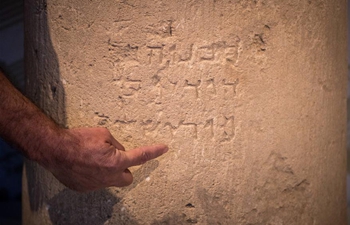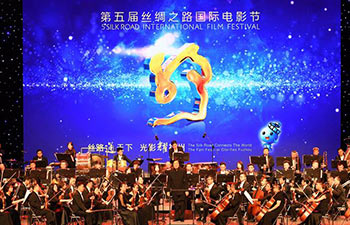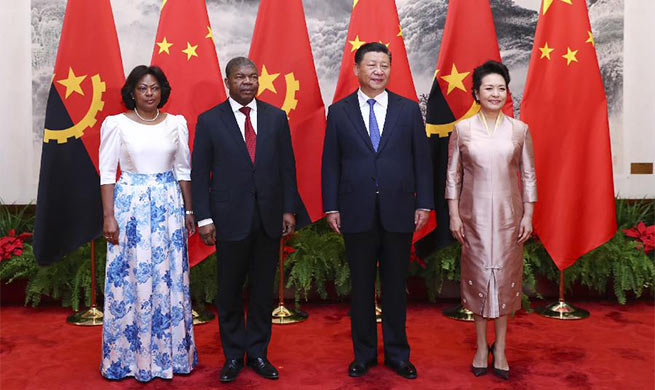NANCHANG, Oct. 9 (Xinhua) -- Standing behind a white curtain amid the dramatic sound of drums, Ding Yongfa tells the story of a corrupt official brought to justice in a special performance by silhouette figures.
This is not a scene from a film, but a traditional Chinese shadow puppet performance, where the silhouette figures made from cowhide show how Yan Peitian, a righteous official, fought his corrupt peer during the Qing Dynasty (1644-1911).
Behind the curtain is the soul of the performance -- puppeteer Ding Yongfa. Using his flexible hands and voice, he makes the small figures stroke their beards, nod their heads, wave their hands and curse others.
"This story is my latest creation," said Ding, 55, a villager in Xiangdong District of Pingxiang City, in eastern China's Jiangxi Province. "It tells how a local official named Yan Peitian in Xiangdong fights one of his peers who cruelly tortured innocent people."
Ding said he wants to use the puppets to show the anti-corruption drive going on in China.
"The public welcomes the campaign against corruption, and I thought it would be a good way to show the campaign through art."
The anti-graft campaign is gaining momentum in China. In August, for example, a total of 7,846 officials were punished for violating the Party's eight-point frugality code, according to the top anti-graft body of the Communist Party of China (CPC).
It is under such circumstances that Ding came up with the idea of exposing corruption via shadow puppet performances.
"I thought it would be a good idea," Ding said. "I can not only pass on the traditional art but also help spread education against corruption among the public."
Shadow puppetry has a long history. Ancient Chinese historical records show that shadow puppet plays were originally created by a Chinese Taoist during the Han Dynasty (202 BC-AD 220) to console Emperor Wu, who was heartbroken after losing one of his imperial concubines. The Taoist made a stone image of the concubine and projected it in a tent with candle light. The shadow looked so vivid that it helped the emperor out of the grief.
Over the next 2,000 years, the stone figures were gradually replaced by cowhide ones, and the tents were turned into curtains. Performers then added drum sounds and Chinese opera to accompany the movement of the figures, and the shadow play was born.
Shadow plays went through a hiatus during the tumult of the Cultural Revolution between 1966 and 1976 but re-emerged shortly after in the early 1980s, when the art was involved in rural marriage ceremonies, funerals and banquets.
In Xiangdong District, where the art has developed for more than 200 years, Ding is a fifth-generation inheritor of shadow puppetry, starting to learn the art at age of 11.
"He is a master of shadow puppetry, and we thought the idea of combining the art with anti-graft theme would be a good idea," said local discipline inspection official Huang Yunzhang.
Huang said that in the eyes of many, anti-graft education can be dry, but shadow puppetry has enlivened such education.
"To make the education more understandable and enjoyable, we supported Ding's idea, and provided whatever sources he needed," Huang said.
Ding spent more than two months creating the script and developing it into a show. He also made a short film about the story and put it online, which was "well received," he said.
Local officials helped Ding develop the story into different sections, which were all put into shadow puppet performances.
But Ding's current success did not come easy.
As the modern home entertainment devices like TV sets and radios became popular, the traditional art form gradually lost its appeal among the younger generation, many of whom from rural areas moved to the cities for better jobs after the reform and opening-up in the late 1970s.
"During the worst times, I could only perform a few times a year because nobody invited me," Ding recalled.
In June 2011, China issued a law protecting intangible cultural heritage. In the same year, shadow puppetry was put on a list of intangible cultural heritage by UNESCO.
To help with the art's survival, local authorities in Xiangdong purchased modern stereo systems, electronic musical instruments and caption-generating machines.
The nationwide campaign of "sending traditional operas to rural areas" to enrich people's lives boosted attendance, and Ding's performances have not only proved to be popular in Xiangdong but also in neighboring provinces like Hunan and Guangdong.
"These days, I can do more than 100 performances a year," Ding said. "Anti-corruption performances are very popular."
He said it is important to pass on the traditional art in new forms.
"We should follow the tide of the new era and revitalize shadow puppetry," he said.

















